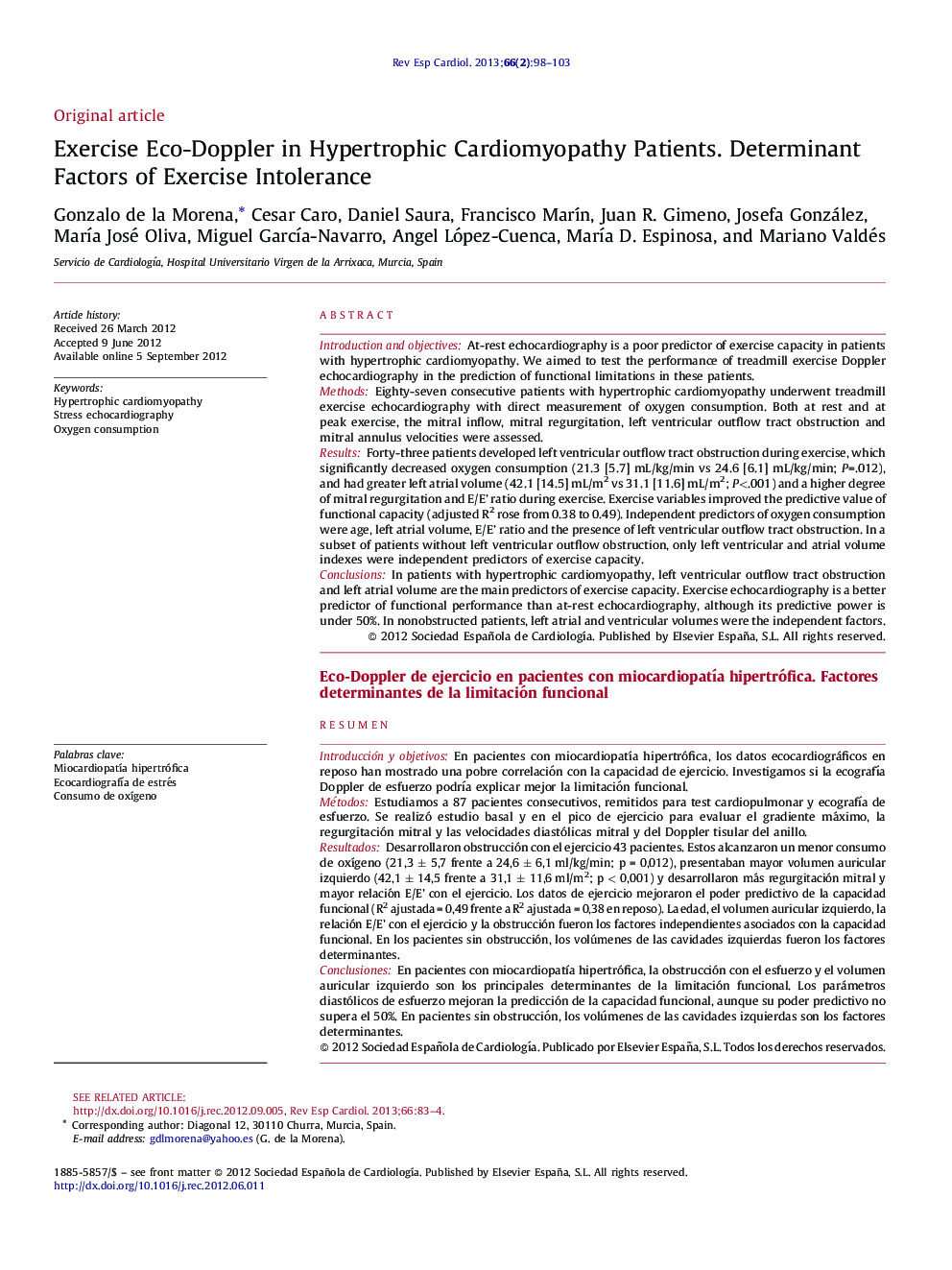| کد مقاله | کد نشریه | سال انتشار | مقاله انگلیسی | نسخه تمام متن |
|---|---|---|---|---|
| 3017784 | 1182133 | 2013 | 6 صفحه PDF | دانلود رایگان |

Introduction and objectivesAt-rest echocardiography is a poor predictor of exercise capacity in patients with hypertrophic cardiomyopathy. We aimed to test the performance of treadmill exercise Doppler echocardiography in the prediction of functional limitations in these patients.MethodsEighty-seven consecutive patients with hypertrophic cardiomyopathy underwent treadmill exercise echocardiography with direct measurement of oxygen consumption. Both at rest and at peak exercise, the mitral inflow, mitral regurgitation, left ventricular outflow tract obstruction and mitral annulus velocities were assessed.ResultsForty-three patients developed left ventricular outflow tract obstruction during exercise, which significantly decreased oxygen consumption (21.3 [5.7] mL/kg/min vs 24.6 [6.1] mL/kg/min; P=.012), and had greater left atrial volume (42.1 [14.5] mL/m2 vs 31.1 [11.6] mL/m2; P<.001) and a higher degree of mitral regurgitation and E/E’ ratio during exercise. Exercise variables improved the predictive value of functional capacity (adjusted R2 rose from 0.38 to 0.49). Independent predictors of oxygen consumption were age, left atrial volume, E/E’ ratio and the presence of left ventricular outflow tract obstruction. In a subset of patients without left ventricular outflow obstruction, only left ventricular and atrial volume indexes were independent predictors of exercise capacity.ConclusionsIn patients with hypertrophic cardiomyopathy, left ventricular outflow tract obstruction and left atrial volume are the main predictors of exercise capacity. Exercise echocardiography is a better predictor of functional performance than at-rest echocardiography, although its predictive power is under 50%. In nonobstructed patients, left atrial and ventricular volumes were the independent factors.
ResumenIntroducción y objetivosEn pacientes con miocardiopatía hipertrófica, los datos ecocardiográficos en reposo han mostrado una pobre correlación con la capacidad de ejercicio. Investigamos si la ecografía Doppler de esfuerzo podría explicar mejor la limitación funcional.MétodosEstudiamos a 87 pacientes consecutivos, remitidos para test cardiopulmonar y ecografía de esfuerzo. Se realizó estudio basal y en el pico de ejercicio para evaluar el gradiente máximo, la regurgitación mitral y las velocidades diastólicas mitral y del Doppler tisular del anillo.ResultadosDesarrollaron obstrucción con el ejercicio 43 pacientes. Estos alcanzaron un menor consumo de oxígeno (21,3 ± 5,7 frente a 24,6 ± 6,1 ml/kg/min; p = 0,012), presentaban mayor volumen auricular izquierdo (42,1 ± 14,5 frente a 31,1 ± 11,6 ml/m2; p < 0,001) y desarrollaron más regurgitación mitral y mayor relación E/E’ con el ejercicio. Los datos de ejercicio mejoraron el poder predictivo de la capacidad funcional (R2 ajustada = 0,49 frente a R2 ajustada = 0,38 en reposo). La edad, el volumen auricular izquierdo, la relación E/E’ con el ejercicio y la obstrucción fueron los factores independientes asociados con la capacidad funcional. En los pacientes sin obstrucción, los volúmenes de las cavidades izquierdas fueron los factores determinantes.ConclusionesEn pacientes con miocardiopatía hipertrófica, la obstrucción con el esfuerzo y el volumen auricular izquierdo son los principales determinantes de la limitación funcional. Los parámetros diastólicos de esfuerzo mejoran la predicción de la capacidad funcional, aunque su poder predictivo no supera el 50%. En pacientes sin obstrucción, los volúmenes de las cavidades izquierdas son los factores determinantes.
Journal: Revista Española de Cardiología (English Edition) - Volume 66, Issue 2, February 2013, Pages 98–103